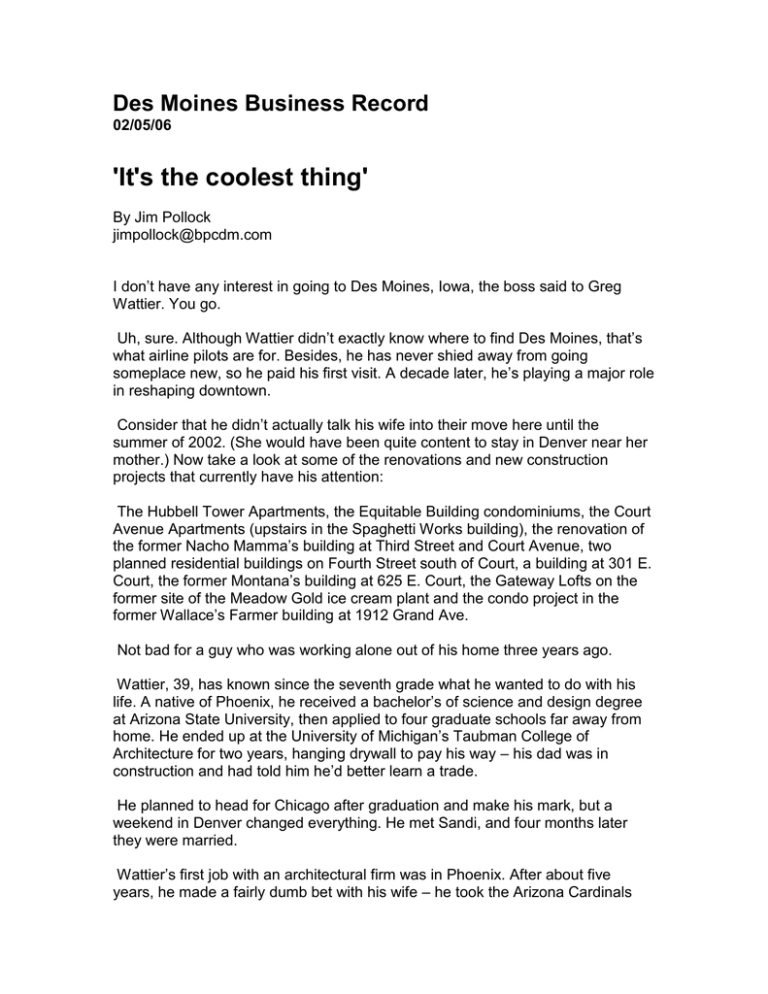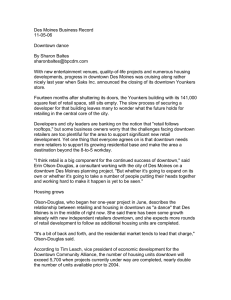'It's the coolest thing' Des Moines Business Record
advertisement

Des Moines Business Record 02/05/06 'It's the coolest thing' By Jim Pollock jimpollock@bpcdm.com I don’t have any interest in going to Des Moines, Iowa, the boss said to Greg Wattier. You go. Uh, sure. Although Wattier didn’t exactly know where to find Des Moines, that’s what airline pilots are for. Besides, he has never shied away from going someplace new, so he paid his first visit. A decade later, he’s playing a major role in reshaping downtown. Consider that he didn’t actually talk his wife into their move here until the summer of 2002. (She would have been quite content to stay in Denver near her mother.) Now take a look at some of the renovations and new construction projects that currently have his attention: The Hubbell Tower Apartments, the Equitable Building condominiums, the Court Avenue Apartments (upstairs in the Spaghetti Works building), the renovation of the former Nacho Mamma’s building at Third Street and Court Avenue, two planned residential buildings on Fourth Street south of Court, a building at 301 E. Court, the former Montana’s building at 625 E. Court, the Gateway Lofts on the former site of the Meadow Gold ice cream plant and the condo project in the former Wallace’s Farmer building at 1912 Grand Ave. Not bad for a guy who was working alone out of his home three years ago. Wattier, 39, has known since the seventh grade what he wanted to do with his life. A native of Phoenix, he received a bachelor’s of science and design degree at Arizona State University, then applied to four graduate schools far away from home. He ended up at the University of Michigan’s Taubman College of Architecture for two years, hanging drywall to pay his way – his dad was in construction and had told him he’d better learn a trade. He planned to head for Chicago after graduation and make his mark, but a weekend in Denver changed everything. He met Sandi, and four months later they were married. Wattier’s first job with an architectural firm was in Phoenix. After about five years, he made a fairly dumb bet with his wife – he took the Arizona Cardinals over the Broncos in NFL football – and her reward for winning was that they moved to her hometown of Denver. “It was a huge change,” Wattier said. “I went from the corporate world to Blue Sky Studios, which was three or four people in blue jeans, working in an abandoned warehouse and creating things they called lofts in LoDo (Lower Downtown). “I found my passion right there; it’s the coolest thing to rejuvenate an old building.” Six or seven years passed. The idea of starting his own business seemed daunting, so Wattier just kept working and learning. Then a client, Mark Kline, told the Blue Sky gang about his plan to buy a warehouse in his hometown of Des Moines and turn it into loft residences. Wattier ended up spending a year and a half traveling between here and Denver to work on the Brown-Camp Lofts at 100 Market St. “By the end of that time, I started liking a lot of things here,” Wattier said. “The people I met were incredibly genuine, and I love the fact that it’s a big city and a little city at the same time.” And he saw that Des Moines was poised for a lot of the same downtown housing renovation that Wattier had learned to do in Colorado. In 2002, he moved to a house in Beaverdale with Sandi and their two sons, having lined up exactly one client. The father-son team of Steve and Tom Howard had engaged him to do the Tone Lofts near Brown-Camp while he was still at Blue Sky. Now they had other projects in mind. “Steve is in some ways a mentor,” Wattier said. “He’s been very encouraging, and their goals align with mine; they’re interested in not being mediocre.” But one client does not keep an architectural practice busy. When Wattier learned that Meredith Corp. had sold the former home of Wallace’s Farmer magazine at 1912 Grand Ave., he found out who bought it, called him and hopped on a plane for Oklahoma City. “That was very unusual for an architect, and I was impressed by it,” said Nick Preftakes, president of Precor Realty Advisors Inc. and the buyer of the building. “I was also impressed by the fact that upon his arrival, he really understood what we were trying to accomplish. As a developer, you have in your head what you want to do with a project, but you have varying degrees of success communicating that to others, especially architects.” Wattier landed the job, and it led to an assignment to work on Precor’s plans for the Gateway Lofts at 1719 Grand Ave. More local connections were forming, too. Before he even moved to Des Moines, Hubbell Realty Co. had hired him as a consultant on downtown housing projects after seeing his name tied to Brown-Camp. Now the company pulled him into the Hubbell Building renovation and the Court Avenue projects. “We knew it took a different mindset to do downtown renovation loft work as opposed to new construction,” said Steve Niebuhr, senior vice president of development and management services at Hubbell. “Greg seemed to have that insight. With lofts, the less you do, the more people seem to like it, and that raw, edgy feel is what Greg brought to the table.” Harry Bookey, president of BH Equities LLC, has worked with Hubbell on the long effort to redo Court Avenue, and he hired Wattier to work on residential building renovations in Chicago, Houston and Minneapolis. “He’s creative; he’s willing to put some ideas out there that are a little unconventional,” Bookey said. “I think that’s good. He understands the game.” Bookey travels extensively and tries to stay up to date on what’s being done in other markets, so he values Wattier’s experience elsewhere. “He’s had a lot of exposure to some of the more unique techniques in our business,” Bookey said. “It comes with the territory. Once people start doing downtown housing, they want to make it something you can’t necessarily get in suburban-type buildings.” G.E. Wattier Architecture Inc. now has 13 full-time employees: one is the office manager, and the rest are architects or interior designers. Most have come through the programs at Iowa State University. As he added staff, Wattier moved his offices from his house to Brown-Camp, to 223 E. Walnut St. and now to 325 E. Fifth St., constantly looking for more space. Now he’s up to 2,000 square feet in the ever-cooler East Village. “I don’t want to talk about it, but this space isn’t going to cut it,” Wattier said. “But the annual G.E. Wattier moving party is expensive, too.” The next business move is to expand beyond downtown housing in Des Moines. The firm is working to add school and church projects outside Central Iowa. However, there still could be plenty to do right here. “People who have been here a long time are jaded, but I don’t have that history,” Wattier said. “When I measure the strides the city has made in the past three years, not the past 20, I get a very different perspective.” And, as Wattier says, “I tend to roll the dice.”



